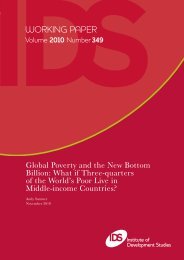Patterns of time use in Tanzania: how to make public investment in ...
Patterns of time use in Tanzania: how to make public investment in ...
Patterns of time use in Tanzania: how to make public investment in ...
Create successful ePaper yourself
Turn your PDF publications into a flip-book with our unique Google optimized e-Paper software.
5. Home ma<strong>in</strong>tenance<br />
5.1. Food preparation<br />
The activities <strong>of</strong> food preparation <strong>in</strong>clude gr<strong>in</strong>d<strong>in</strong>g, cutt<strong>in</strong>g, heat<strong>in</strong>g water,<br />
actual cook<strong>in</strong>g, sett<strong>in</strong>g tables and serv<strong>in</strong>g, and clean<strong>in</strong>g up after a meal.<br />
Healthy and carefully prepared meals are essential for the nutritional status <strong>of</strong><br />
both children and adults, as well as contribut<strong>in</strong>g <strong>to</strong> their broader sense <strong>of</strong><br />
well-be<strong>in</strong>g. Food preparation is the activity <strong>in</strong> which differences between<br />
women and men appear most marked. As illustrated <strong>in</strong> Table 5.1.1, almost the<br />
entire female population (95 percent <strong>of</strong> adult women) devote a share <strong>of</strong> their<br />
average day <strong>to</strong> prepar<strong>in</strong>g food while only 35 percent <strong>of</strong> men do. The gap<br />
between women and men is strik<strong>in</strong>g also as far as duration is concerned.<br />
Adult women on average spend 153 m<strong>in</strong>utes per day (or about two hours and<br />
a half) cook<strong>in</strong>g while adult men spend on this task about 47 m<strong>in</strong>utes.<br />
Table 5.1.1: Participation rate, mean <strong>time</strong> among participants and mean <strong>time</strong><br />
among population by sex for adults<br />
All Female Male<br />
Percentage (%)<br />
Participation rate 66.7 94.9 35.1<br />
Absolute m<strong>in</strong>utes per day<br />
Mean among<br />
participants 126.4 152.6 47.4<br />
Mean among population 84.3 144.8 16.6<br />
Source: Calculations from the 2006 <strong>Tanzania</strong> TUS<br />
Does location matter?<br />
As s<strong>how</strong>n <strong>in</strong> Table 5.1.2, rates <strong>of</strong> participation <strong>in</strong> food preparation are higher<br />
<strong>in</strong> rural areas than <strong>in</strong> urban areas for both women and men, but the average<br />
duration <strong>of</strong> this task appears higher <strong>in</strong> urban areas. Both urban women and<br />
urban men spend at least 10 m<strong>in</strong>utes longer than rural women and men<br />
prepar<strong>in</strong>g food and cook<strong>in</strong>g. Further analysis could break down the activity<br />
<strong>of</strong> food preparation <strong>in</strong> its many components <strong>to</strong> identify which <strong>of</strong> the tasks<br />
take more <strong>time</strong> between rural and urban areas.<br />
Table 5.1.2: Participation rate, mean <strong>time</strong> among participants and mean <strong>time</strong><br />
among population by sex and location<br />
Adult females Adult males<br />
Rural Urban Rural Urban<br />
Percentage (%)<br />
Participation rate 95.9 92.2 36.8 31.0<br />
Absolute m<strong>in</strong>utes per day<br />
Mean among participants 148.6 163.4 44.6 55.8<br />
Mean among population 142.5 150.6 16.4 17.3<br />
Source: Calculations from the 2006 <strong>Tanzania</strong> TUS<br />
22

















